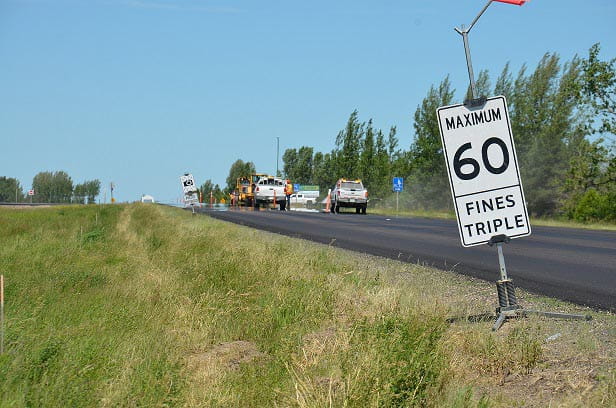Released on June 23, 2016
With a record $1.15 billion Highways and Infrastructure budget to be invested this year, road crews are busy across the province. The ministry would like to remind motorists to drive carefully and obey posted speeds in work zones.
It is important to note that black and white maximum 60 km/hr speed limit signs remain posted when workers are not present, if road hazards exist.
“It can be frustrating, driving 60 km/hr in construction zones when workers are not present,” Highways and Infrastructure Minister Nancy Heppner said. “Please remain patient and obey posted speed limits – it will ensure your trip is safe and your vehicle isn’t damaged.”
If the speed limit is 60 km/hr, without workers present, it is because there are safety hazards, such as:
- loose stones or a sharp drop in the pavement;
- barriers in place to guide traffic;
- a narrow road; or
- completed road work needs time to dry and could be slippery at high speeds.
Upcoming construction projects in the province include:
- Paving on Highway 2 north of Diefenbaker Bridge including construction of turning lanes and the installation of three culverts; and
- A new bridge on Highway 165 over Bow River near La Ronge.
A photo gallery featuring current work can be found at www.highways.gov.sk.ca/photos/.
If you’re planning a trip this summer, check the Highway Hotline at
http://hotline.gov.sk.ca/map/. The Highway Hotline provides up-to-date information on construction, emergency road closures, the status of ferries, barges and other road activities.
Information is also available by calling 306-787-7623 in Regina, 306-933-8333 in Saskatoon and toll-free across Canada at 1-888-335-7623. You can report a highway work zone signing problem by calling 306-244-5535. When providing information, please provide the location, highway number as well as the time and day.
The Government of Saskatchewan has invested $6.3 billion in transportation infrastructure since 2008, improving more than 11,000 kilometres of Saskatchewan roads.
-30-
For more information, contact:
Sonja Orban
Highways and Infrastructure
Regina
Phone: 306-787-8484
Email: sonja.orban@gov.sk.ca

